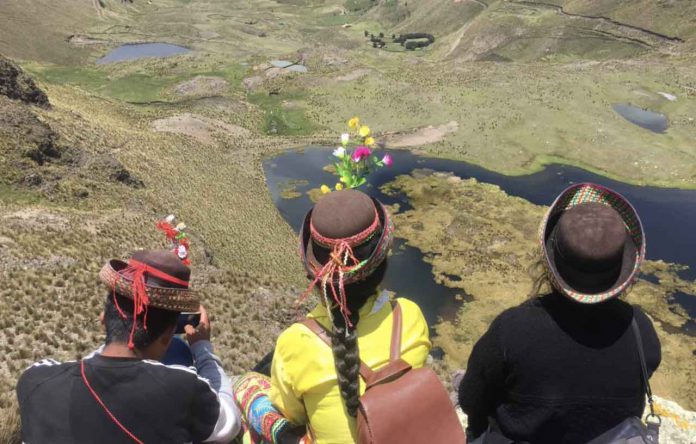
Drug traffickers and coca farmers have targeted more territory in Peru’s central Amazon region since the coronavirus pandemic
- Illicit coca trade is growing in Peru’s central Amazon region
- Indigenous groups face rising land invasions and violence
- Experts say corruption hinders efforts to tackle the issue
By Dan Collyns
FLOR DE UCAYALI, Peru – (Thomson Reuters Foundation) – One evening last November, hooded and masked men wielding automatic rifles walked onto the village green in the middle of Flor de Ucayali, an indigenous Amazon community in Peru.
Firing in the air, they demanded to know the whereabouts of the village’s leaders.
Just months earlier, a young indigenous mother with her infant daughter had been surprised at her homestead by armed men who knocked her down, and threatened her. The woman was so scared that she left the community to live in a nearby city, neighbours said.
Following that assault, Saul Martinez – the Apu or leader of the Shipibo-Konibo community of 265 people – imposed a three-month curfew, ordering the women and children to sleep in the village hall and the men to perform guard duty at night.
Shipibo-Konibo leaders also reported ongoing invasions of their land to the prosecutor’s office in Ucayali last November, but the armed men “keep appearing,” Martinez said.
“They sent messages that if we did not desist (from reporting the incursions), they would take out those responsible, the leaders,” he said, noting that images of dismembered bodies were sent to his mobile phone.
Flor de Ucayali is among at least 100 indigenous communities in the central Amazon region of Ucayali that have been threatened in recent years by invading coca farmers, who grow the crop used to make cocaine for drug trafficking gangs.
More than a dozen indigenous and Amazon activists have been killed since the COVID-19 pandemic began, Peru’s human rights coordinator said, as criminal networks exploited lax enforcement to target land to grow coca, as well as for illegal mining and logging.

That represents a spike in such murders in Peru, where six defenders were killed in 2020 alone, said rights group Global Witness.
Coronavirus restrictions made remote regions even more vulnerable by constraining state efforts to protect land and eradicate illegal coca cultivation, according to Vladimir Pinto, Peru field coordinator for the advocacy group Amazon Watch.
Martinez, of Flor de Ucayali, said he had requested state protection for his community but was told by police to “take care of yourselves” as they did not have budget to make the boat journey from the regional capital Pucallpa, under three hours away.
“Are we living in the Peruvian state or somewhere else?,” Martinez asked.
BOWS, ARROWS AND DRONES
Peru is the second-biggest cocaine producer after Colombia, responsible for more than a quarter of global output, the United Nations says.
The area covered in coca fields in Peru grew from 439 sq km (170 square miles) in 2016 to 617 sq km in 2020, a more than 40% increase, according to government data.
However, the White House Office of National Drug Control Policy (ONDCP) recorded a higher figure for 2020 – about 882 sq km, or enough land to potentially produce 810 tonnes of cocaine.
Coca growing is a major driver of deforestation in Peru, which lost a record 2,000 sq km of forest in 2020, almost four times higher than the 2019 total.
The environmental damage does not end there. Jungle cocaine laboratories also release toxic chemicals such as sulphuric acid, acetone and gasoline into the subsoil, streams and rivers.
While the invaders threatening Flor de Ucayali’s territory are violent and better armed, the young men and women of the community are unbowed.
Equipped with five donated bulletproof vests and a couple of shotguns, as well as bows and arrows, they patrol forest that extends to the border with Brazil.

“We’ll keep on defending ourselves even if we must die,” said Christian Tangui, 30, leader of the village’s self-titled surveillance committee and the father of a young family.
Tangui said he could not bear to see his children scared anymore by intruders – even if patrolling to try to stop them meant serious danger for guards.
The community investigates newly-deforested spots with the help of state-run Programa Bosques, which updates a satellite map of their land monthly.
Drones help them have a broader view of their land – but drug traffickers use the technology as well, to avoid military raids.
During one recent patrol, indigenous defenders said they were forced to flee into the forest when intruders fired shots.
Robert Guimaraes, a longtime indigenous leader regionally and nationally, said that he had not seen such a level of organized crime in Ucayali before the pandemic.
“The situation is very serious because there are authorities colluding with drug trafficking,” he said, citing the alleged involvement of regional officials, judges and prosecutors.
Ucayali’s governor, Francisco Pezo Torres, is in preventive detention facing trial for allegedly leading a criminal organization in the regional government.
He was arrested in December, initially escaping via a false door in his property, but was recaptured days later.
Be it taking bribes to grant irregular land concessions or blocking indigenous titles, corruption is fueling environmental crime and deforestation across the Peruvian Amazon, said Alvaro Masquez, a lawyer at Legal Defence Institute, a rights group.
‘APPARATUS OF ORGANIZED CRIME’
Ricardo Soberon, since 2021 the head of Peru’s anti-drug agency DEVIDA, said the pandemic had been a turning point with drug trafficking increasingly directed through remote, hard-to-reach parts of the Amazon often occupied by indigenous people.
Under his leadership, Soberon said the agency would reverse a previous policy that sought to tackle illegal coca cultivation by promoting individual land titles to grow alternative crops, such as coffee and cacao.

The policy, applied between 2013 and 2018, allowed regional authorities to grant thousands of the titles in Peru’s Amazon while overlooking indigenous rights to communally held land – a change that activists say actually fueled drug trafficking and deforestation.
“Far from securing the Amazonian territories, (individual land titles) have put them on a platter so that interests linked to drug trafficking, illegal mining and illegal logging can expand at the expense of communal territories,” added Soberon, who previously held the top job at DEVIDA between 2011 and 2012.
Guimaraes is among many indigenous Amazonian leaders who say police and prosecutors are failing to follow up on their reports of death threats, allowing killers to operate with impunity.
“We are facing a whole apparatus of organized crime, of organized assassination,” he said. “Our community is titled, however it does not have the protection of the state.”
As the Shipibo-Konibo people fear for their land and their lives, the Kakataibo indigenous group represent a chilling illustration of the potential dangers ahead.
Arbildo Melendez, a Kakataibo leader, was shot dead in April 2020 in the Unipacuyacu community – 150 km from Flor de Ucayali – after having reported the presence of drug gangs to the authorities.
His community remains under siege from coca farmers who have cleared swathes of forest. Unipacuyacu’s 86 families have retreated to just 1% of its 230-sq-km territory, and Melendez’s widow and four children are in hiding, fearing more violence.
Herlin Odicio, leader of the Kakataibo federation, also has been forced into hiding in another town after death threats mounted, and his relatives have been attacked by armed men.
Despite this, Odicio has been elected as a town councillor and has helped to get state approval to create two new indigenous reserves for his people, who want to live in isolation in their new 1,500 sq km territory.
“Unfortunately this (death threat) is for life and this persecution will continue,” he said. “I will always defend my people, the struggle of my people. I will not remain silent.”







